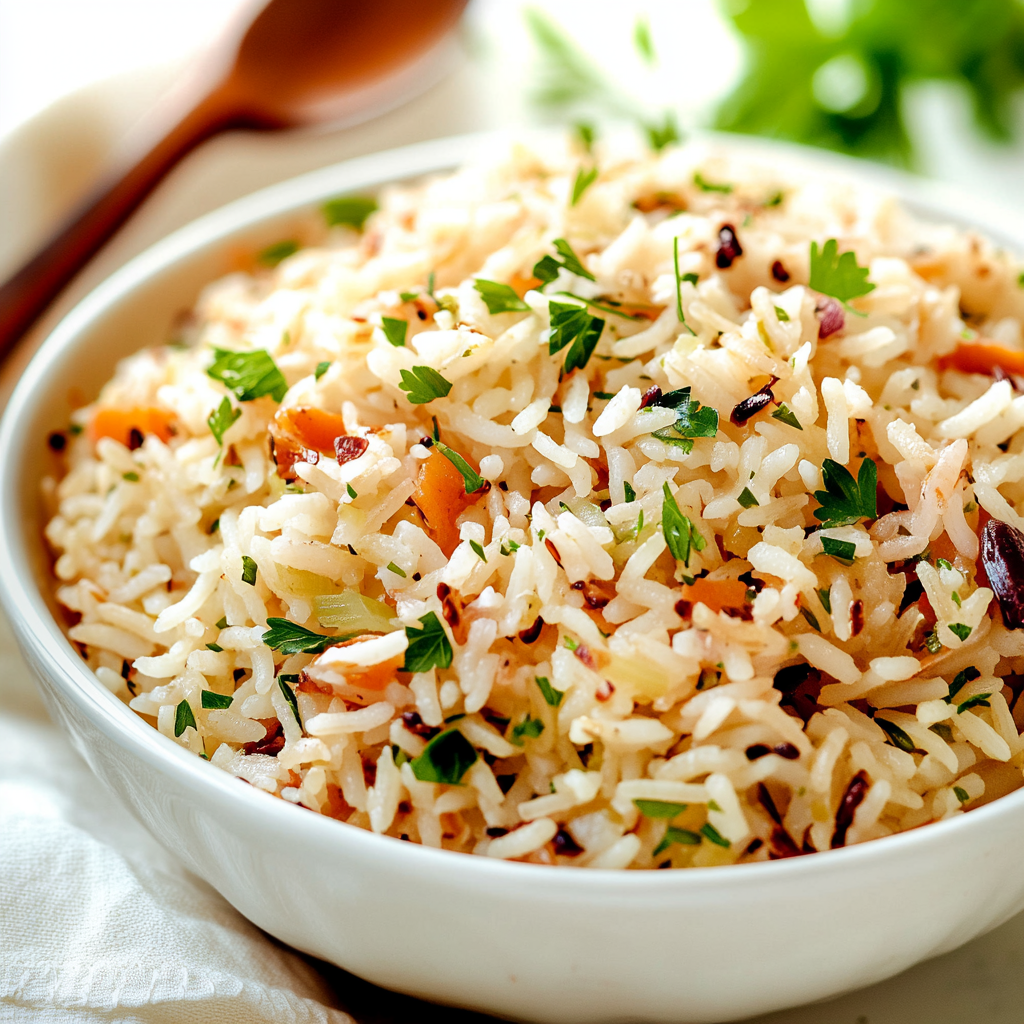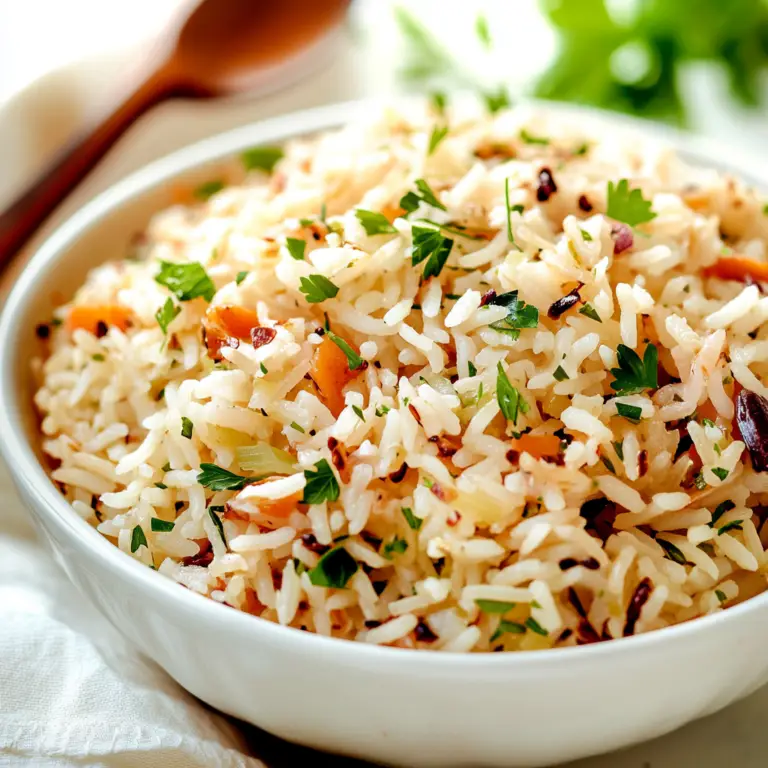Have you ever experienced the comforting embrace of a warm bowl of rice pilaf? This dish offers a delightful blend of textures and flavors that tantalize your taste buds. With each fluffy grain infused with aromatic spices and savory broth, rice pilaf is more than just a side dish; it’s an experience waiting to be enjoyed.

Rice pilaf is the perfect companion for any meal or gathering, whether it’s a cozy family dinner or an elegant celebration. Imagine serving it alongside roasted meats or grilled vegetables; the subtle nuttiness and fragrant herbs will elevate your dining experience. Plus, it’s incredibly versatile—easy to customize with your favorite ingredients like nuts, dried fruits, or fresh herbs. Get ready to impress your family and friends with this simple yet delicious dish.
Why You’ll Love This rice pilaf
- Versatility: Rice pilaf can easily adapt to any meal or occasion. You can incorporate various vegetables, spices, or proteins to create a unique dish tailored to your taste.
- Quick Preparation: This recipe comes together quickly, making it an ideal choice for weeknight dinners when time is limited.
- Flavorful Comfort: The combination of broth and seasonings creates a warm, inviting flavor that pairs beautifully with numerous dishes.

Ingredients for rice pilaf
Here’s what you’ll need to make this delicious dish:
- Long-Grain Rice: Opt for high-quality long-grain rice like basmati or jasmine for optimal texture and flavor.
- Vegetable Broth: Using vegetable broth instead of water adds depth and richness to the flavor profile.
- Onion: A finely chopped onion enhances the aroma and contributes sweetness as it caramelizes during cooking.
- Garlic: Fresh minced garlic brings a robust flavor that complements the other ingredients well.
- Olive Oil: Use extra virgin olive oil for sautéing the onions and garlic; it adds healthy fats and flavor.
The full ingredients list, including measurements, is provided in the recipe card directly below.
How to Make rice pilaf
Follow these simple steps to prepare this delicious dish:
Step 1: Sauté Aromatics
In a medium saucepan over medium heat, heat olive oil. Add finely chopped onion and sauté until translucent, about 5 minutes. Stir in minced garlic and cook for another minute until fragrant.
Step 2: Toast the Rice
Add long-grain rice to the saucepan. Stir well to coat the grains in oil and cook for about 2-3 minutes until they turn slightly golden.
Step 3: Add Broth
Pour in vegetable broth carefully. Bring the mixture to a boil while stirring gently.
Step 4: Simmer
Reduce heat to low once boiling. Cover the saucepan tightly with a lid and let simmer for about 18-20 minutes until all liquid is absorbed.
Step 5: Fluff the Rice
After cooking time is up, remove the saucepan from heat but leave covered for another five minutes. Fluff the rice gently with a fork before serving.
Step 6: Serve Warm
Transfer the fluffy rice pilaf onto plates or into bowls as a hearty side dish that elevates any main course.

Tips and Tricks
Here are some helpful tips to ensure the best results for your dish:
- Use Quality Ingredients: Fresh ingredients yield better flavor; opt for organic vegetables when possible.
- Let It Rest: Allowing the cooked rice to rest covered helps achieve better texture by letting steam redistribute moisture evenly.
- Add Nuts or Dried Fruits: For added texture and sweetness, consider mixing in toasted almonds or dried cranberries before serving.
Mistakes to avoid
- Using the wrong rice variety: Selecting the appropriate type of rice is crucial for a perfect rice pilaf. Long-grain varieties such as basmati or jasmine are ideal because they remain fluffy and separate when cooked. Avoid using short-grain rice, which tends to become sticky and clumpy. This can lead to a dense texture instead of the light, airy dish you desire. Always check the packaging for the right recommendations based on your recipe.
- Skipping the toasting step: Toasting the rice in oil or butter before adding liquid enhances its flavor significantly. Many people skip this step, thinking it’s unnecessary, but this mistake can leave your rice pilaf bland. The process not only adds depth but also helps each grain stay distinct during cooking. Make sure to toast the rice until it turns golden and aromatic for the best results.
- Not measuring liquids accurately: Precision is key when making rice pilaf. Using too much or too little liquid will alter the texture of your dish. The standard ratio is usually two parts liquid to one part rice for long-grain varieties. If you add too much water, your pilaf may turn out mushy; too little will leave it undercooked. Always measure carefully for a consistently successful outcome.
- Neglecting seasoning: Failing to season your rice pilaf properly can result in a bland dish. Many cooks overlook this essential step, thinking that ingredients like broth will provide enough flavor. However, adding salt and spices during cooking infuses each grain with taste and aroma. Be sure to taste as you go and adjust seasoning accordingly for a well-balanced dish that excites your palate.
Serving Suggestions
This rice pilaf is versatile and pairs wonderfully with:
- Grilled Chicken – The light, fluffy texture of rice pilaf complements the savory flavors of grilled chicken perfectly. Add a side of grilled vegetables for a balanced meal.
- Roasted Vegetables – Enhance your dish by serving rice pilaf alongside a medley of roasted seasonal vegetables. This combination offers a colorful plate and a burst of flavor.
- Lamb Chops – For a heartier meal, pair rice pilaf with lamb chops. The rich taste of the lamb contrasts beautifully with the delicate spices in the pilaf.

FAQs
What is the best type of rice for making rice pilaf?
For making rice pilaf, long-grain varieties such as basmati or jasmine rice work best. These types of rice cook up fluffy and separate, which is ideal for achieving that perfect texture in pilaf. Basmati rice adds a fragrant aroma and subtle nutty flavor, making it a popular choice. You can also use brown rice for a healthier option; however, remember that cooking times may vary. Always rinse the rice before cooking to remove excess starch, ensuring that your final dish remains light and doesn’t become sticky.
Can I make rice pilaf ahead of time?
Yes, you can prepare rice pilaf ahead of time! It’s an excellent dish for meal prep because it reheats well. To make it in advance, simply follow the recipe and let it cool completely before storing it in an airtight container in the refrigerator. When you’re ready to serve it, gently reheat on the stovetop or in the microwave. If you find that it’s too dry after reheating, add a splash of broth or water to refresh its texture.
What spices are commonly used in rice pilaf?
Rice pilaf typically features a variety of spices that enhance its flavor profile. Common spices include bay leaves, cumin, coriander, and sometimes cinnamon for warmth. Additionally, you might find herbs like parsley or cilantro added just before serving for brightness. The use of sautéed onions or garlic at the start also contributes to its aromatic quality. Feel free to experiment with spices to suit your taste!
Is rice pilaf gluten-free?
Yes, traditional rice pilaf is gluten-free as it primarily consists of rice and broth or water for cooking. However, if you choose to add ingredients like orzo or certain pre-packaged seasonings, be sure to check their labels for gluten content. To ensure your dish remains gluten-free, stick with pure ingredients like vegetables and spices that are verified gluten-free.
Conclusion for rice pilaf
In conclusion, rice pilaf is a delightful dish that brings together simplicity and flavor in one bowl. By choosing long-grain varieties like basmati or jasmine rice and complementing them with aromatic spices and herbs, you can create an inviting side or main course suitable for any occasion. Whether served with grilled chicken or roasted vegetables, this versatile recipe adapts beautifully to various tastes and preferences. Preparing it in advance allows you to enjoy this satisfying dish anytime while remaining gluten-free when made traditionally. Enjoy experimenting with different flavors as you make this classic favorite!

Easy and Flavorful Rice Pilaf Recipe
Rice pilaf is a delicious and aromatic side dish that elevates any meal with its fluffy grains and rich flavors. This recipe features long-grain rice, sautéed onions, and garlic, all simmered in vegetable broth for a comforting dish that’s both simple and versatile. You can easily customize rice pilaf by adding your favorite ingredients like nuts, dried fruits, or fresh herbs to create a unique flavor profile. Perfect for family dinners or special occasions, this easy-to-make rice pilaf will impress your guests with its delightful taste and enticing aroma.
- Total Time: 35 minutes
- Yield: Serves 4
Ingredients
- 1 cup long-grain rice (basmati or jasmine)
- 2 cups vegetable broth
- 1 medium onion, finely chopped
- 2 cloves garlic, minced
- 2 tablespoons extra virgin olive oil
Instructions
- In a medium saucepan over medium heat, add olive oil and sauté the chopped onion until translucent (about 5 minutes). Stir in minced garlic for another minute until fragrant.
- Add the long-grain rice to the saucepan, stirring well to coat the grains in oil. Toast for about 2-3 minutes until slightly golden.
- Carefully pour in vegetable broth and bring the mixture to a boil while stirring gently.
- Once boiling, reduce heat to low and cover tightly. Simmer for 18-20 minutes until all liquid is absorbed.
- Remove from heat but leave covered for an additional five minutes. Fluff the rice gently with a fork before serving warm.
- Prep Time: 10 minutes
- Cook Time: 25 minutes
- Category: Side Dish
- Method: Sautéing
- Cuisine: Mediterranean
Nutrition
- Serving Size: 1 cup (185g)
- Calories: 280
- Sugar: 1g
- Sodium: 350mg
- Fat: 8g
- Saturated Fat: 1g
- Unsaturated Fat: 6g
- Trans Fat: 0g
- Carbohydrates: 47g
- Fiber: 3g
- Protein: 6g
- Cholesterol: 0mg






